Honestly, most of us are not a lumberjack, who interact with chainsaws and axes from a young age. Therefore, we need guidance on how to cut down trees over 90% of the time. Before you pick up an axe/chainsaw and cut a tree, you should consider a few things, which we have highlighted in this review.
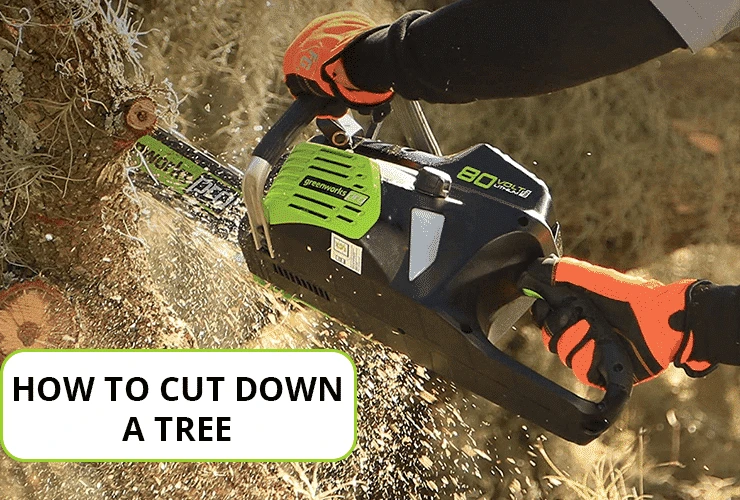
Note: Before felling a tree, check your local bylaws to know whether you will need a permit to fall the tree. To avoid future issues, do not skip this step.
How to Cut Down a Tree Correctly (and safely)
Videos of people attempting to cut down trees, only for them to fall in the wrong direction, often on a home or car are abundant online. Inexperienced and inappropriately trained individuals are the most affected, necessitating training on cutting down trees correctly and safely.

Tree cutting, or felling, is a demanding and dangerous job that requires a bit of skill to do correctly. While felling trees seem like common knowledge, statistics show that emergency rooms report several hundred chainsaw injuries suffered while feeling trees every year.
There are numerous right way and many wrong ways of felling trees. Unlike what people think, there is a science to this process. To minimize the risk of personal injuries and damage to properties and boost safety overall, we have highlighted a few worthy steps and measures that you should take.
Husqvarna Video | How to Cut Down A Tree
What You’ll Need | Tree Felling
While preparing to cut a tree, make sure that you have the correct equipment. These often vary depending on your skill and the type or size of the tree you are planning to cut but should include cutting tools and safety gear. Follow this general checklist to fell most trees like a professional:
Protective Gear:
- A hard helmet or hat.
- A safety visor or goggles that protect the eyes and face.
- Effective hearing protection.
- Heavy-duty work gloves.
- Closed-toe shoes or steel-toed boots.
- Kevlar chaps.
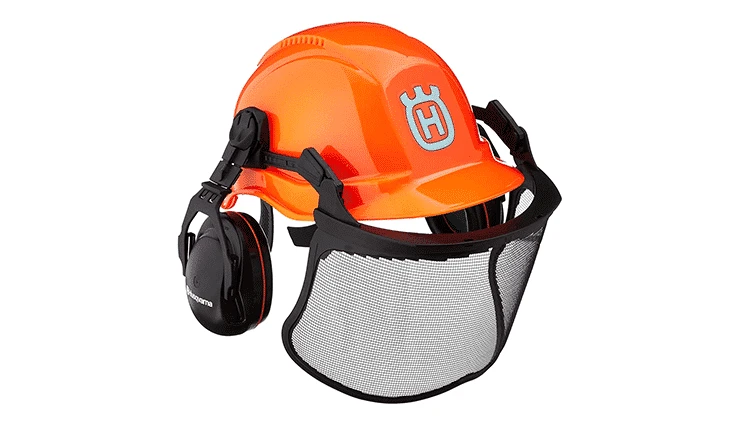
Tree felling is a daunting chore that strains the eyes and ears. Therefore, to handle the process safely, wear a visor or safety goggles to protect your eyes from flying chips. Falling limbs are also health hazards, and therefore a hard hat is critical. The Husqvarna ProForest Chainsaw Helmet System is one of the safest in the market because of its superior design. For a few dollars, you get a 100% secure, adult-sized helmet with hearing protection and a safety visor.
You will also need a pair of protective Kevlar chaps to protect your legs as they offer immediate protection whenever your chainsaw slips. These are readily available in most retail and hardwood stores in most localities.
You should also consider ordering the full Husqvarna Chainsaw Protective Apparel Powerkit (531307180) package from a reputable store. Yes, it costs slightly more money. Thus, if you have a tight budget, I do not recommend it.

Tree Cutting Tools:
- High-performance chainsaw with a sharp chain
- Tree Felling wedges
- An axe
If you ask any professional the tricks for cutting down a tree, one of the most common responses you will get is that you will need a top-grade chainsaw with a sharp chain. Husqvarna manufactures some of the best chainsaws, renowned for its durability and ability to handle most heavy-duty jobs.
The axe handles multiple jobs, including creating notch, marking trees for back cuts, and driving felling wedges. Moreover, you can use an axe instead of a gas or battery-powered chainsaw whenever you are cutting small trees.
Felling Wedge | Essential Tool
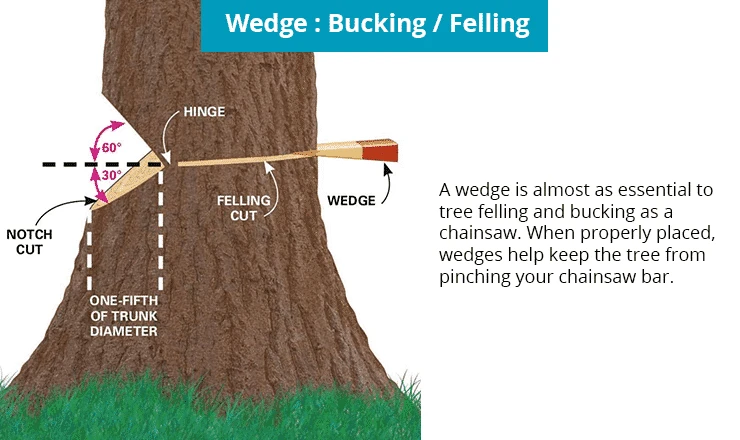
While making a back cut, trees tend to rock back and forth before they eventually fall. To minimize the sway, prevent your chainsaw from binding, and maximize safety, use a tree wedge. Made from plastic or aluminum, they protect chainsaw and stop trees from falling in the wrong direction.
Additional items you may need:
- Long, heavy-duty cable or cable
- First Aid Kit (Seriously)
Whenever a tree leans in a different direction from where you want it to fall, a sturdy cable can help you pull it back to the direction you want it to fall. Accidents can happen in an instant. Therefore, it is good practice to have a first aid kit around as a precautionary measure for such in eventualities.
Video | Safe Tree Felling
Using the Right Chainsaw to Fell a Tree
Whenever you are felling a “troublesome” tree, especially those with double trunks or thick trunks, an average chainsaw might not do a good job. It will frustrate you, drain you, fatigue you, and thus boost the risk of having a severe injury. Look for an efficient chainsaw that you can handle effortlessly.
Husqvarna 435 | Compact
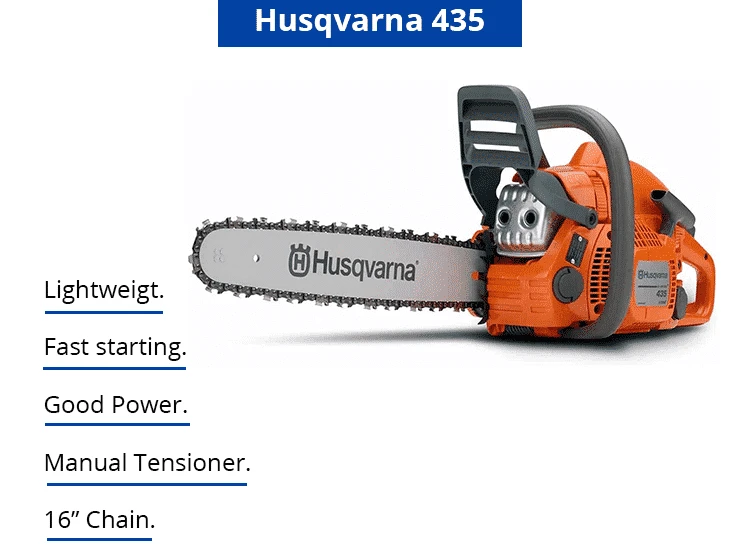
A gas-powered chainsaw is the best for cutting thick trees as they faster, powerful than electric chainsaws, and need less effort to operate in most settings. Unfortunately, they are also heavier, louder than electric chainsaws, and require regular maintenance to work seamlessly for many years.
If you are a new homeowner have just a few small trees to cut, you will do well with the 16-inch Husqvarna 435 gas-powered chainsaw. It is compact yet packed with many convenient features, including combined start/stop switch doe turning it on and off in minutes. Other notable features that make it a top choice for beginners include its ergonomic trigger and handle and lightweight design. Weighing around 9 pounds – it is light for a gas chainsaw.
Husqvarna 450 | Timeless

The Husqvarna 450 is the perfect choice for average landowners who occasionally cut, limb, or prune trees. The system draws power from a 3.2 horsepower engine that can handle light to medium-duty cutting tasks effortlessly. It also has multiple convenient features that ease its use and ensure smooth operation while in use, including SmartStart technology and LowVib vibration dampening. The saw also has a lightweight frame that does not strain users and a unique, X-Torq engine that consumes very little fuel.
However, if you cut larger and denser trees, the Husqvarna 460 Rancher is the best chainsaw to use. The bar (20-inches0 is slightly larger than average ones while its forged 3-piece crankshaft adds to its durability and reliability.
Common Husqvarna Features
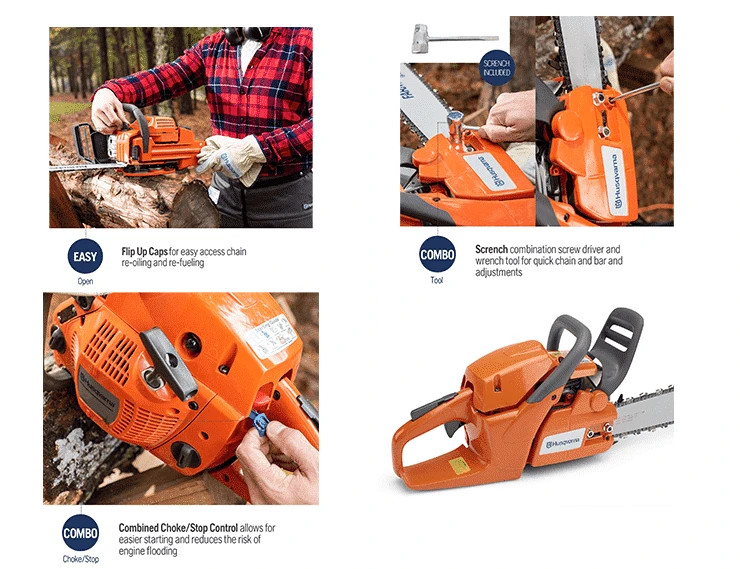
The Remington RMS 51518R Rodeo chainsaw is suitable for individuals who need a valuable chainsaw on a tight budget. It has a robust system that you can use to fell bigger and denser trees without breaking a sweat. The engine is a two-cycle 51cc motor that can withstand heavy abuse for long. Moreover, the saw has a chain brake as an added safety measure, which stops its chain from spinning and injuring you or other people, immediately it detects a kickback.
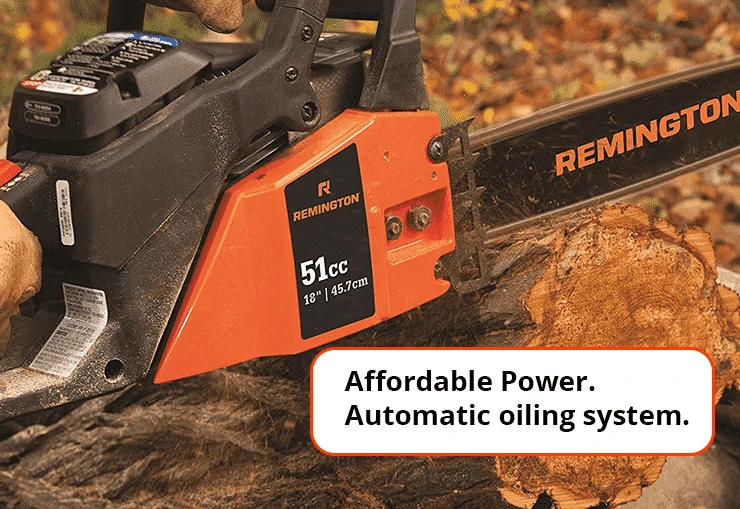
Electric & Battery-Operated Chainsaws
Battery-powered and electric chainsaws are generally lighter and smaller than gas chainsaws, and they do not require regular maintenance of refueling to work. Unlike gas chainsaws, they do not emit toxic fumes but have a slower sawing speed for light-duty tree felling or trimming/pruning small branches.
The Makita UC4051A, for instance, is a renowned 16-inch corded model with a 2,900 FPM chain for heavy-duty cutting. It has a chain oiler (automatic) for maintaining the chain’s efficiency and an oil reservoir (with a window) for checking the oil level on demand. To use the product outdoors seamlessly, you will need a heavy-duty power cord (weather resistant) to boost its coverage.

If you consider ordering a battery-powered chainsaw, Greenworks is a reputable company with many top-rated power tools in its arsenal. Even though most of its products deliver, the 80-volt GreenWorks GCS80420 model provides the best experience in performance and power. It rivals most reputable gas-powered engines in this niche. Like other GreenWorks models, it features a DigiPro Brushless motor that delivers.
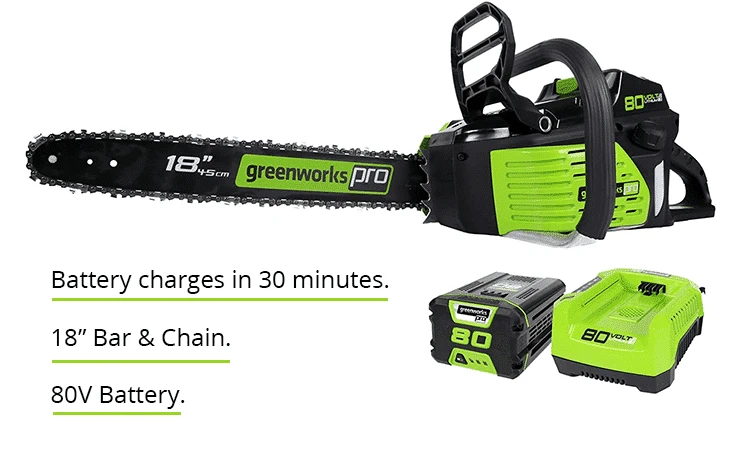
Getting Started | How to Fell A Tree
To have a memorable experience felling trees with a chainsaw, pay attention to the following major steps. First, establish the direction that you want the tree to fall. Analyze the tree then make an accurate and informed decision.
Examining the Tree – When felling trees, gravitational force can be your friend if you can accurately predict your tree’s lean or the direction that it will fall once cut. Therefore, before making the first cut, always check the structure of your tree. Does it have dead branches that might break and hit you as you cut? If your answer is yes, you should not stand between the limbs as they might break off and harm you while cutting the tree. Moreover, always factor the wind direction during the preliminary analysis as it dictates the direction the tree will fall when cut. For safety, always fell a tree in the direction of the wind. If you must do this against the wind’s direction, take precautions that guarantee safety, especially if you are a beginner.
Clear the Drop Zone – trees are tall and heavy and can total cars or damage homes whenever they fall on them. Do your best to avoid such issues by estimating the tree’s size and clearing the landing area. Check the site to ensure that houses, shed, and electrical cables are out of the way. You should also remove brushes or obstacles such as rocks from the area and create a clear escape route for yourself that will keep you safe if things go south.
Prepare the Tree – Most trees grow upright (straight) without leaning forwards or backwards or to the left or write. Such trees are convenient, as you can cut them safely in all directions during a calm day. However, if there is wind take the following additional steps to optimize the cut and thus safety:
- Pull the tree in the direction you want it to fall using a chain or a long rope you jam a wedge in the area you have cut.
- Secure the tree’s base (above your cutting point) with a strap before making the first cut to stop it from splitting.
Make a Notch – Create a notch by making a horizontal cut on the tree’s back in the direction that you want it to fall. Because the tree’s diameter is wider than your chainsaw, the notch will guide the tree to fall in your preferred direction or area as you make a deeper cut in the trunk.
You can do this with a chainsaw or axe but make sure the cut is square (right angle) and not higher than your hip (18-20 inches from the ground). The diameter of the cut should be approximately 1/4-inches, but up to 1/3-inches is acceptable. Then, make another notch around 45-degrees above the first cut and clear the raw wood from the area to reveal a clean notch on the tree.
Felling the Tree
Always make your back cut towards the notch that you have created as it dictates the direction the tree will fall. To have an accurate cut, use a slow running saw to form a circle slightly above the notch
A good guideline to ensure an accurate cut is to circle the tree from above your notch using a slow-running chainsaw to create a mark.
Make your first cut in the direction that you want the tree to fall. Proceed cautiously throughout the process. Once you have cut past you saw’s bar’s depth, drive a wedge into the cut by tapping it with a hammer or the back of an axe, without hamming it into the tree.
As the back cut approaches the notch, stop cutting as the cut will be widening by the second at this point. Do not cut all through to the notch, as you will destabilize the tree, causing it to fall freely, and causing injuries or damaging property. Instead, use the wedge to tip the tree over gently.
Listen for snapping or crackling sounds, as they are indicative that the tree is about to fall. Finally, set back from the tree and let gravity do the rest for you.
Safety Tips | How to Cut Down A Tree
Felling trees is a risky venture that requires you to concentrate on the job to prevent injuries. Focus on the job at hand to avert fatal amateur mistakes.
DO:
- Get to know your chainsaw in-depth. Practice using it on logs or small trees and move to large and more complicated jobs once comfortable.
- Your gas-powered chainsaw should have a full tank of oil and gas before use. If you are using a battery-powered model, charge it fully before use.
- Make sure that you have a secure footing before cutting. The traction should be optimal to protect you from slipping and injuring yourself.
- Your eye should be on the tree at all times. While cutting, stepping away from the tree, or hammering a wedge, watch it to prevent mishaps.
DON’T:
- Do not attempt to fell a tree when intoxicated, tired, or feeling unwell.
- Us a saw that is dull or have physical or mechanical problems to cut.
- Wear open-toed shoes or sandals while felling a tree.
- Do not attempt to fell a tree if you lack the requisite experience, skills, and tools. If you must cut the tree, consult a professional.
From this detailed information on tree felling using a chainsaw, we can learn several things. Do not take shortcuts to save money or time, as the results are often disastrous. Whether the tree you are tackling is small or large, you should prioritize personal/ environmental safety. If you have a tight budget, consult a professional to help you with the job. Most of them have requisite skills and tools and often charge a decent amount so compared available options.
Do you have the correct gear for handling the job you plan to do or need a new set? If no, is it worth buying additional (and necessary) tools and safety gear to tackle the job efficiently? If you cannot afford tools and safety gear, hire professional tree cutting services instead. The companies are diverse and offer tree-cutting services at different rates, depending on the size, location, and type of the lot and the number of trees to cut. Therefore, you could pay a couple of hundred dollars or thousands.
Before cutting a tree, you should also factor your confidence in your abilities to feel trees. If you are working close to power lines, the highway, or houses, let a professional handle the process for you for safety. Ask around to identify reputable companies, compare prices, and then select the best one for the job.




